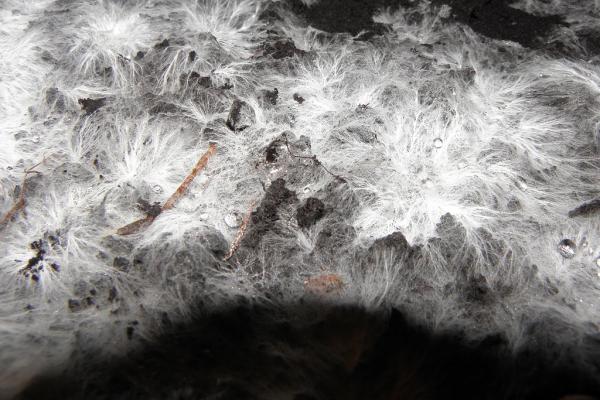The installation, called Hy-Fi, was designed and created byThe Living, an architectural design studio in New York. Each of the 10,000 bricks had been made by packing agricultural waste andmycelium, the fungus that makes mushrooms,into a mould and letting them grow into a solid mass.This mushroom monument gave architectural researcher Phil Ayres an idea.‘It was impressive,’saidAyres, who is based at the Centre for Information Technology and Architecture in Copenhagen, Denmark. But this project and others like it were using fungus as a component in buildingssuch as brickswithout necessarily thinking about what new types of building we could make from fungi.That’s why he and three colleagues have begun theFUNGARproject – to explore what kinds of new buildings we might construct out of mushrooms.Mushrooms might soundlikean outlandish building material. But there is certainly good reason to drastically rethink construction. Buildingsand constructionare responsible for39% of anthropogenic carbon dioxide emissions– and a whopping 21% of those emissions come just from the making of steel and concrete. Construction also uses vast amounts of natural resources. Take sand, one of the principal ingredients in concrete. It takes a special sort, with just the right roughness, to make concrete. These daysit is a lucrative commodity and controlled in some parts of the world bysand mafiasand stolen bythe boatload from islands.Suchtroubles are set to worsen over the next decades as the world’s population grows faster and gets wealthier. We need a lot more homes and if you do the maths, the amount we need to build is staggering.‘It’s like building a Manhattan every month for the next 40 years,’said Ayres, borrowing a line fromBill Gates.FungibricksCan fungi really help? Absolutely, says mycologist ProfessorHanWostenat Utrecht University in the Netherlands. Fungi are not consumers of CO2 like plants are. They need to digest food and so produce carbon dioxide, like animals do. However, the organic waste streams (such as straw or other low value agricultural waste) that the fungi digest would be degraded to CO2 anyway, either by composting or burning. Plus,fungibricks permanently fix some of that waste inside them and so act as a store of carbon. All this makes fungi buildings a climate win – and certainly miles better than using concrete, steel and bricks.The mycelium composite can be grown over a woven scaffold for a period of 7-10 days, eventually encasing the structure. Image credit – FUNGAR/CITA, 2019-2020The FUNGARproject began in late 2019 and sofarProf.Wostenhas been experimenting with how to make building materials. At Prof.Wosten’slab in Utrecht, the team have been combining mycelium, the ‘roots’ of fungi, with agricultural waste such as straw. Then they allow the fungi to grow for about two weeks, until the fungus has colonised the straw. This binds the straw together, producing a white-ishfoam-like material. Then they heat-treat it to kill the organism. They can also process it, for example by applying coatings or by squashing it.‘If we press it we can get a material like hardboard,’saidProf.Wosten. By varying the type of fungi and agricultural waste, the growth conditions and the post-processing, Prof.Wostensays they are getting all sorts of candidate building materials with different mechanical properties.‘It’s very early days to start saying your house will be made entirely of fungus,’said Ayres. But parts of it already can be.Mogu, a company based near Milan in Italy, already produces and sellssound-dampeningvelvet-texturedwall tilesandfloor tilesbased on mycelium foam. The company’s chief technology officerAntoniGandiais anotherFUNGARproject partner. He said thatMoguis also developingmycelium-basedinsulation materialfor buildings.Ayres is hoping that the FUNGARproject will go way beyond just using fungi-based products as components in existing building designs. He wants to think about what entirely new kinds of building might be made from fungi. Foremost in his mind is building with living fungus.“‘It’s very early days to start saying your house will be made entirely of fungus.’Phil Ayres, Centre for Information Technology and Architecture, Copenhagen, DenmarkLiving fungusThere are two principal advantages to this. First, living fungus might behave as a self-healing material, simply re-growing if it becomes damaged. Second, mycelium networks are capable of information processing. Electrical signals run through them and change over time in a manner almost akin to a brain.‘We’ve discovered that fungal materials respond to tactile stimulation and illumination by changing their patterns of electrical activity,’said Prof.AndrewAdamatzkyat the University of the West of England in Bristol, UK,who iscoordinating the project withAyres.The idea is that perhaps the very structure of a mushroom building might sense and respond to its environment independently.It might for instance sensewhenCO2 levels from the mycelium are building up and open the windows to release the gas,according toGandia.Building with living myceliumwill be abigchallenge. This is because the longeritgrows, the more of the substrate material–the straw, or whateverwaste –itdecomposes.Since the straw gives the materials their structural integrity, allowing the fungi to grow for too long isn’t desirable. There may be ways around this though. Depriving the fungi of water puts it into a dormant state: alive but not growing. Andsoone of Ayres’ideasisto construct walls with two layers of dead fungus enclosing a layer of living fungus inside. This set up would shut out water from the inner layer, keeping the fungus there dormant.Mycolite panels are made by pouring the composite into a mould. Image credit – FUNGAR/CITA, 2019-2020One of the few other people who have explored working with fungiinconstruction isJonathanDessiOliveat Kansas State University in the US. He saysthat working with living mycelium is a very interestingnew ideabecause it offers the possibility of the building being able to heal itself. But for him the real attraction of what he calls‘myco-materials’is that they ‘give us a way of reshaping how we think about the permanence of architecture.‘What if some – not all – of our buildings were meant to only last a coupleofyears and could thereafter be recycled into shelter, food, or energy?’he said.The next major goal for the FUNGARproject is to build a small, freestanding building. They plan to pull that off within a year and then spend time monitoring it as it ages. It is crucial, saysAyres, to be able to monitor the living structure and see how it changes. It isn’t yet clear exactly what sorts of structures might end up being made fromfungi, but they will probably start small.‘I wouldn’t be crossing a bridge made offungi, would you?’joked Prof.Wosten.You might be wondering what happened to Hy-Fi, that igloo-like structure in New York. The answer points to one of the most beautiful things about mycelium buildings. No wrecking ball or slow decay for them. It was taken down and composted.The research in this article was funded by the EU.If you liked this article, please consider sharing it on social media.This article was originally published on 14 January 2021.
This article was originally published in Horizon, the EU Research and Innovation magazine.
Add to favorites:
Share:
Listing Description
Video
Documents
No documents available.
Ask KETMarket to make a contact
Connect with the Listing Owner!
💬 Please log in now to askKETMarket to make a contact. Not a member yet? Sign up for free and start connecting today!
Video
Related Funding and Finance Opportunities
Unlock Exclusive Funding Opportunities!
🔑 Get instant access to tailored funding opportunities that perfectly match your needs. This powerful feature is exclusively available to our premium members—helping you save time, stay ahead of the competition, and secure the right funding faster.
Upgrade to Premium now and never miss an important opportunity again! Already a premium member? Log in here to explore your matches.
Related Innovation Offers
Discover Tailored Innovation Offers!
🚀 Gain access to technology solutions that match your specific needs and interests—carefully selected to support your innovation goals. These offers are exclusively available to our premium members, helping you identify relevant technologies faster and start the right conversations with potential partners.
Upgrade to Premium now and explore your personalized technology matches today! Already a premium member? Log in here to view your tailored offers.
Related Knowledgeable Resources
Discover More with Premium: Related Knowledge Resources
🔒 You’re missing out on expert-curated knowledge specifically matched to this topic. As a Premium member, you gain exclusive access to in-depth articles, guides, and insights that help you make smarter decisions, faster.
Whether you’re preparing a funding proposal, researching a new market, or just need reliable information—our Premium knowledge matches save you hours of research and point you directly to what matters.
Upgrade to Premium now and instantly unlock relevant knowledge tailored to your needs! Already a member? Log in here to view your personalized content.

